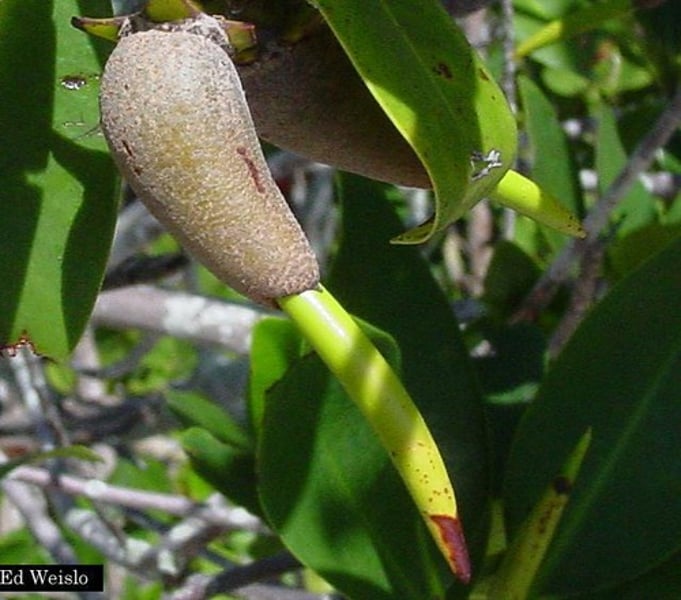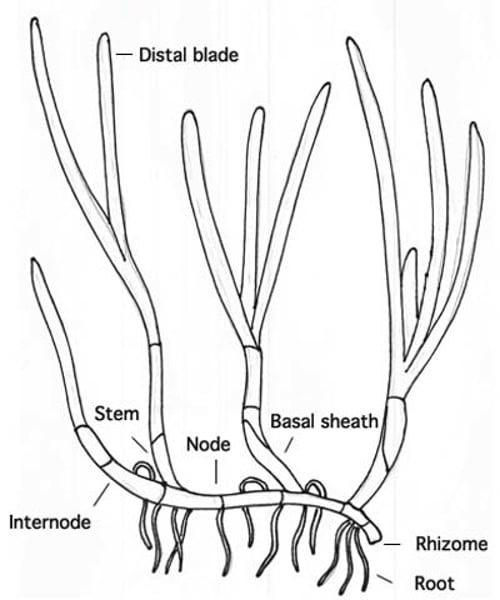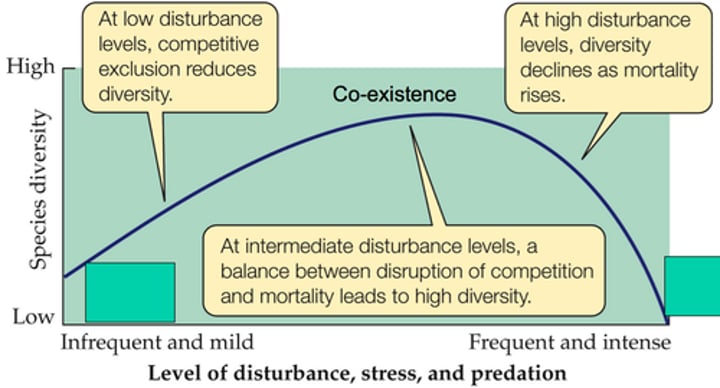marine environment 2
1/23
There's no tags or description
Looks like no tags are added yet.
Name | Mastery | Learn | Test | Matching | Spaced |
|---|
No study sessions yet.
24 Terms
mangroves
line around 75% of tropical coasts
found in the intertidal zone, so they need to survive both marine and terrestrial conditions
home to a diverse community of plants and animals
considered a very harsh environment to survive in
mangrove distribution
throughout tropical and subtropics
temperate equivalent biome are salt marshes
low energy sites (minimal wave action) due to grounding of seeds and root formation
many penetrate upstream
diversity varies geographically- greatest= indo-pacific, caribbean
mangrove adaptations: high salinity
salt interferes with cellular biochemical processes
salt disrupts water potential gradients and causes problems with osmoregulation
red mangrove roots cells have very thick, impermeable membranes that exlude 90-97% of the salt
black and white mangroves have glands on their leaves that excrete salt into the environment
sacrifical leaf
selective leaf abscission
red mangroves use this technique to deal with the salt that is not excluded at the roots
on every branch there is a leaf that sacrifices its photosynthetic abilities and becomes a dedicated salt storage organ - toxic effects of salt cause yellowing - when the leaf is salt saturated it is dropped and a new leaf takes over the role
mangrove adaptations: reproduction
recruitment success is very low, mangroves produce high numbers of propagules
viviparous - young stay attached to their parents until they are large enough to survive the journey across the sea
propagules are positively buoyant which enables exchange of genetic information between forests so mangroves must settle in low energy sites
a spear-shape facilitates settlement in fine sediment

mangrove adaptation: unstable sediment
when a juvenile initially settles it immediately grows prop roots that help maintain its upright position
as the tree develops more, props grow more and act like a tripod
complex root systems enable trees to withstand storms and large waves
roots do no penetrate deeply therefore trees have adaptation for oxygen and nutrient obtainment
prop root structures produce amounts of habitat structure and house lots of biodiversity
mangrove adaptations: anoxic sediment
soil/sediment is completely anoxic; it smells like rotten eggs because of an abundance of sulphurous bacteria
fine particles fall out of suspension and prevent the formation of air pockets from which oxygen can be extracted
mangroves have evolved two major adaptations to enable absorption of atmospheric oxygen
lenticels: pores in their bark that can take in oxygen
black mangroves have pnumatophores which are modified roots that come out perpendicularly from a horizontal rhizome; gasses are exchanged over their surfaces
importance of mangroves
Entrapment of sediments (biostabilisation) prevents it reaching the reef which could smother corals.
Provides a major habitat for insects, other invertebrates, fish, birds, and small mammals.
Acts as a nursery ground for many species of fish, shrimps, lobsters and crabs.
An important source of firewood and building materials for local communities.
A source of important food species (fish and shellfish) for human populations.
Heavily linked with coral reef diversity and productivity (habitat connectivity).
Carbon sequestration (Blue Carbon).
threat to mangroves
high rates of deforestation for prawn and shrimp ponds and crab and fish farms; also for charcoal burning in some areas
removed for coastal development
pollution-sewage, oil and industrial effluent
local harvesting for firewood and building materials
global sea level rise restricts the areas mangroves can exist
seagrasses
vascular (superior) plants
contribution to global primary production
critical to stabilization of sediments
provide habitat and food to many marine organisms
provide protection to other important coastal ecosystems
seagrass anatomy
blade - main photosynthetic organ
short shoot - stem
rhizome - horizontal stems and root like structure that connects adjacent short shoots together and anchors the plant to the substrate
root - anchor plants, absorb nutrients and excrete waste

seagrass sexual reproduction
pollen and seeds are carried by currents and maybe by animal faeces
can establish new meadows and allows exchange of genetic material
seagrass asexual reproduction
shoots detach from the main plant and form new individuals
helps meadows to grow in size and density
*rhizomes also allow meadows to grow
importance of seagrass beds
Provide an important habitat for fish and invertebrates, and a nursery ground for others (habitat connectivity).
Act as an important food source for charismatic species like dugongs/manatees and turtles
They bind sediment (biostabilisation) which helps keep water clear so more light can reach the seagrass and the nearby corals.
They are major sinks for nutrients, which helps clean the water and prevent water quality declining (which can lead to increased growth on coral reefs).
Support important fish and shellfish fisheries which provide food to humans.
Carbon sequestration (Blue Carbon).
threats to seagrass
indirect threats- increased turbidity which reduces light for photosynthesis, disease
Eutrophication - although seagrass beds are nutrient sinks, too much nutrients increase phytoplankton which shades seagrass beds
Dredging/anchoring - major effect which physically damages the seagrass, often due to coastal development.
Removal for tourism - just to make tourists more comfortable! This disrupts the fragile equilibrium of the local marine environment and increases erosion from the land
Recreational activities - Boat propellers and vessels running aground can cause damage which takes years to recover from
what is a coral reef
mound/ridge of living coral, coral skeletons, and calcium deposits from other sea organisms that resides in the ocean
many different plants and animals contribute to the reef's construction
most important are corals which is why they are known as ecosystem architects
certain species of coral produce a calcium carbonate skeleton
successive generations of these corals lay down their skeleton on those of previous generations
a coral reef is a result of millions of years of coral skeletons
reef builders
The organisms that actually produce the reef structure
algae - red coralline algae, green encrusting
shells of worms, snails, clams
bryozoans and crustaceans
why are coral reefs important?
support up to 1 billion people for food and livelihood (expected to double by 2050)
Extremely high biodiversity and productivity
They provide coastal protection against storms and tsunamis
They have a huge potential to provide future medicines
They are highly sensitive to human pressure and climate change
By 2050 75 % of the world reefs will be severely impacted
why is caribbean diversity lower?
caribbean and pacific were once connected allowing genetic material to move between them freely
however, north and south america were joined by the panama isthmus
caribbean suffers more storms which reduces diversity

factors influencing coral reef distribution
light intensity- required for photosynthesis of algae living symbiotically within corals - this limits corals to shallower waters
salinity- corals cannot tolerate low salinity but they can high salinity
sedimentation- high sedimentation reduces light levels and smother corals
emersion- no coral species can withstand regular or prolonged time out of water
temperature- require temps above 19c, elevated temps can cause bleaching
Dawin's subsidence theory
starts with a volcanic island that becomes extinct - as the island and ocean floor subside, coral growth builds a fringing reef, often including a shallow lagoon btwn the land and the main reef - as the subsidence continues ,the fringing reed becomes a larger barrier reef further from the shore with a bigger and deeper lagoon inside - ultimately the land sinks below the sea, and the barrier reef becomes an atoll ecnclosing an open lagoon
the great coral reef paradox (darwin's paradox)
warmer waters result in tropical oceans being bery low in nutrients (ogliotrophic) but coral reefs are one of the most productive ecosystems on planet
nutrient cycling on reefs is incredibly tight (75% is recycled)
individual coral reef islands and atolls can increase the nearshore phytoplankton biomass ( up to 86% over oceanic areas)
threats to coral reef
destructive fishing- techniques that destroy the reed structure as collateral damage
coral mining- destroys the physical structure of the reef and reduces coastal protection from reefs
tourism- coastal developments can cause pollution and sedimentation while diver/anchor damage destroy reefs
invasive species- species introduced to an area can have devastating ecological impacts
overfishing- removing fish above a sustainable level, removes key species from the reef
pollution- increased nutrition can lead to phase shifts and can increase coral disease
deep sea corals
although discovered over 250 years ago, they remained unstudied due to technical limitations
widely distributed in earth's ocean, including tropical areas
lack zooxanthellae, exclusively heterotrophs. slow growth rate
very diverse community
main threats - submarine cables, trawling, ocean acidification